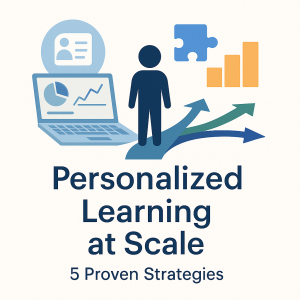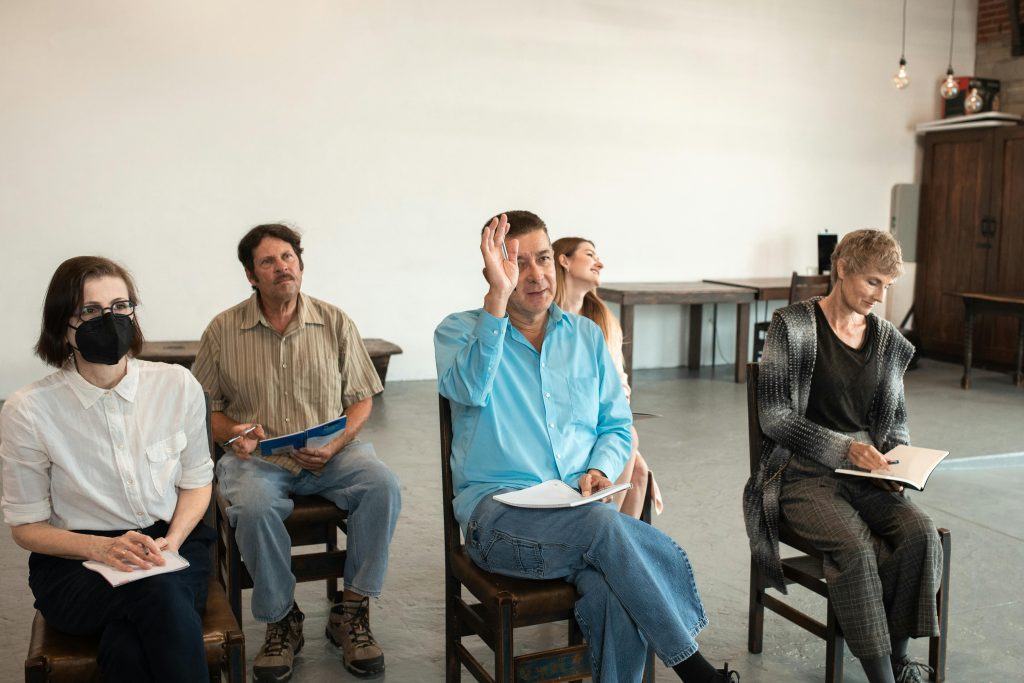In today’s classrooms, no two learners are the same—and yet, many schools still rely on one-size-fits-all teaching models that leave students either bored or behind. As education evolves, so does the need to personalize learning experiences without burning out teachers or breaking systems. But how do we scale that kind of personalization across hundreds—or thousands—of students?
This blog explores five proven strategies for personalized learning at scale. From adaptive technology to learner agency, we’ll show you how real districts are moving beyond the myth and making customization work—efficiently, equitably, and at scale.

Ms. Chen’s Dilemma: The Personalization Paradox
Ms. Chen sat hunched over her desk, a cup of coffee long gone cold. Her 30-student roster glared back at her like a Rubik’s cube with the colors mixed all wrong. Jamal couldn’t sit still for five minutes, Maria needed extra scaffolding, and Priya was already two chapters ahead. How do you meet each learner where they are without cloning yourself?
If you’ve ever felt like Ms. Chen—trying to individualize learning in a system designed for standardization—you’re not alone. Across districts and countries, educators are discovering a hard truth: one size fits none.
And yet, personalization at scale often feels like a unicorn—desirable, but mythical.
That’s where Principal Rodriguez enters our story.
Why Personalized Learning at Scale Feels Impossible
When Principal Rodriguez took over the Maplewood School District, she was full of ambition. Her vision? A district where every student progressed at their own pace, explored learning aligned to their passions, and left school genuinely future-ready.
But within months, she hit the wall:
- Teacher Resistance: “We don’t have time to customize lessons for every student!”
- Tech Limitations: Systems didn’t talk to each other. Tools were clunky.
- Data Overload: Tons of numbers, but little insight.
- Equity Concerns: Some students had devices at home. Others didn’t.
- Assessment Bottlenecks: How do you grade personalized paths?
These are the classic challenges of personalized learning at scale. They’re real. And they’re solvable.
The key lies not in scaling perfection—but in strategically designing for flexibility, feedback, and empowerment.
Let’s break down how.
The Paradigm Shift: From Personalization for the Few to Scale for All
Scaling personalized learning isn’t about creating 1:1 learning plans for 10,000 students. It’s about building systems, tools, and mindsets that adapt around the learner, not the other way around.
Principal Rodriguez realized she didn’t need to reinvent the wheel—just upgrade the engine to personalized learnings at scale. She and her team adopted 5 strategies for personalized learning at scale. Within a year, Maplewood’s student engagement increased by 18%, and grade-level mastery in math rose by 22%.
Ready to explore those strategies on how to scale personalized learning at scale? These strategies not only develop personalized learning at scale bit also helps in implementing personalized learning at scale.
Strategy 1: Leveraging Adaptive Personalized Learning at Scale

What & Why
Adaptive learning technology scale solutions use algorithms to modify content delivery based on student performance in real-time. This lets learners progress at their own pace while receiving support tailored to their needs.
Think of it like GPS for learning—adjusting the route when a student hits traffic or a wrong turn.
How to Implement
- Identify core subjects (e.g., Math, Literacy) where adaptive platforms make the biggest impact.
- Ensure tech integration with existing LMS for seamless data flow.
- Start with pilot classrooms before district-wide rollout.
- Train teachers to analyze data, not just administer tech.
Maplewood Case Study
Principal Rodriguez introduced an adaptive math platform in Grades 4–6. Students were grouped not by grade but by competency. In 6 months, below-grade-level students showed 2x growth in computation fluency.
Common Hurdles & Fixes
- Pitfall: Over-reliance on tech = disengaged teaching.
- Solution: Blend adaptive tech with teacher-led instruction.
- Pitfall: Inequitable access.
- Solution: Provide offline access and device lending programs.
Strategy 2: Building Dynamic Learner Profiles for Scalable Differentiation (Personalized Learning at Scale)
What & Why
Learner profiles are living documents that capture student strengths, needs, goals, and preferences. They’re the backbone of scalable differentiation and a tool for student agency.
When done right, they evolve with the learner—not gather dust in a digital folder.
How to Implement
- Create a district-wide learner profile template using data-driven instruction principles.
- Include: academic progress, social-emotional indicators, interests, and goals.
- Involve students in profile creation and updates.
- Use these profiles to inform small-group instruction and project design.
Maplewood Case Study
Rodriguez’s team created digital learner profiles updated quarterly. Teachers used them during planning. Students referenced them during goal-setting. Over 70% reported feeling “seen and understood.” That is the magic of personalized learning at scale.
Common Hurdles & Fixes
- Pitfall: Profiles become static reports.
- Solution: Make updating part of advisory periods or PBL check-ins.
- Pitfall: Data silos.
- Solution: Use learning record stores to unify academic and behavioral data.
Strategy 3: Embedding Competency-Based Progression and Mastery Learning

What & Why
Competency-based progression means students advance upon mastery—not seat time. It aligns with mastery learning principles and removes the pressure to “teach to the middle.” With personalized learning at scale, everyone can be focused upon equally.
It’s like letting every student run their own race, instead of marching in lockstep.
How to Implement
- Identify priority competencies for each grade level.
- Redesign assessments to measure mastery, not completion.
- Allow retakes and revisions tied to specific feedback.
- Use flexible pathways (projects, presentations, simulations) to demonstrate learning.
Maplewood Case Study
In science, Rodriguez piloted this model. Students could choose between lab reports, videos, or presentations to show understanding. Results? 91% mastery rates—up from 62% the previous year.
Common Hurdles & Fixes
- Pitfall: Grading confusion.
- Solution: Adopt a 1-4 mastery scale with clear rubrics.
- Pitfall: Pacing challenges.
- Solution: Offer enrichment for early finishers and scaffolds for those needing more time.
Strategy 4: Empowering Student Agency with Choice Boards & Voice
What & Why
Student agency is the secret ingredient in sustained engagement. When learners have a say in what, how, and when they learn, motivation skyrockets.
This doesn’t mean chaos. It means structured choice.
How to Implement
- Introduce choice boards aligned to standards.
- Use project-based learning for authentic voice integration.
- Involve students in designing success criteria.
- Hold monthly “voice panels” to gather feedback on learning experiences.
Maplewood Case Study
Rodriguez’s team piloted “Flex Fridays,” where students pursued interest-based projects. One 8th grader built a podcast series on climate change—and later used it in her high school application.
Common Hurdles & Fixes
- Pitfall: Too much choice = overwhelm.
- Solution: Curate high-quality options within guardrails.
- Pitfall: Inconsistent rigor.
- Solution: Align all choices to core competencies.
Strategy 5: Using Learning Analytics to Drive Scalable Decisions

What & Why
Learning analytics help leaders see patterns, not just anecdotes. They power decision-making across curriculum, intervention, and equity.
It’s the dashboard you need when piloting a rocket.
How to Implement
- Choose platforms that provide real-time, actionable dashboards.
- Train staff on interpreting data (not just collecting it).
- Use heat maps, trend lines, and growth metrics to track progress.
- Tie analytics to data-driven instruction cycles every term.
Maplewood Case Study
Maplewood used dashboards to track attendance dips, assessment lags, and student well-being. One insight: students with fewer than 3 advisory check-ins per month were 40% more likely to fail a class. They immediately revised advisory schedules.
Common Hurdles & Fixes
- Pitfall: Data fatigue.
- Solution: Set 3-5 priority metrics per grade level.
- Pitfall: Privacy concerns.
- Solution: Adhere to FERPA & anonymize non-instructional data.
The Teacher’s Critical Role in Scaling Personalization
No tool, strategy, or platform can replace the magic of a skilled educator. In personalized learning at scale, teachers become:
- Learning architects, designing experiences based on profiles and mastery goals.
- Mentors, guiding reflection and emotional growth.
- Data interpreters, turning charts into actionable next steps.
How to Support Teachers
- Professional Development: Focus on teacher role in personalization and tools.
- Collaborative Planning Time: Embed time for analyzing learner data.
- Coaching & Peer Observation: Normalize iterative practice.
When Rodriguez invested in teacher coaching, staff retention jumped 12%, and teacher-reported efficacy rose sharply.
Measuring Success at Scale
You can’t improve what you don’t measure. These indicators reveal if your strategies for personalized learning at scale are working:
| Metric | What It Shows |
|---|---|
| Mastery Progress Rates | Effectiveness of competency-based progression |
| Student Engagement Surveys | Impact of agency and choice |
| Growth Scores (MAP, iReady) | Learning acceleration from adaptive tech |
| Profile Update Frequency | Use of learner profiles in planning |
| Advisory Check-In Logs | Social-emotional impact and learner support |
Tie your analytics to clear goals and revisit them every 6–8 weeks.
Conclusion: The First Step Is Saying No to One-Size-Fits-All
Personalized learning at scale isn’t a fantasy—it’s a framework. With the right strategies, it becomes a daily reality.
Just like Principal Rodriguez, you can transform a district, a school, or even a single classroom.
✅ Start small.
✅ Pilot purposefully.
✅ Gather feedback.
✅ Iterate fast.
Audit your reality: Which of these 5 strategies for personalized learning at scale can you pilot this term? Create your action plan—and let’s leave one-size-fits-all behind.

![The Power of Storytelling in Corporate Training: Igniting Success and Inspiring Growth [2023]](https://trainercentric.com/wp-content/uploads/2023/06/storytelling-1024x576.jpg)

